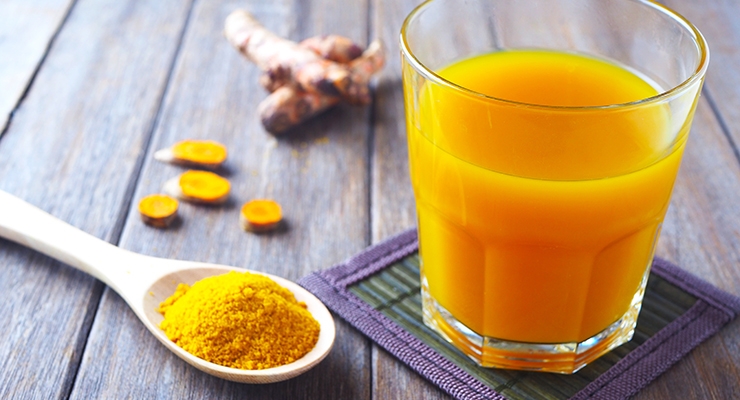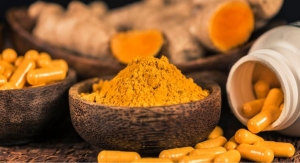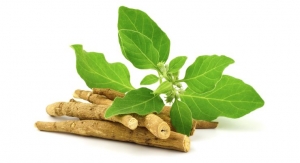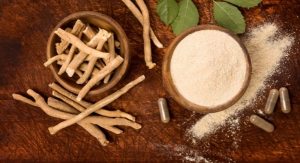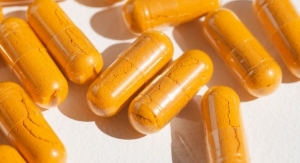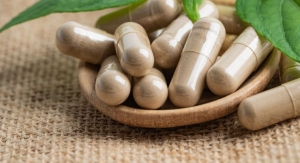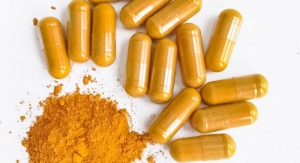By Sean Moloughney, Editor03.28.18
Traditional medicine continues to converge with consumer demand for whole foods and naturally functional ingredients. At the same time, scientific research and modern technology have led to new understanding of how traditional herbs affect health and enabled companies to fine-tune how best to deliver their beneficial compounds.
Total U.S. retail sales of herbal dietary supplements surpassed $7 billion in 2016, growing 7.7% from the previous year, according to the American Botanical Council’s (ABC’s) annual market report published in HerbalGram last year. Focus on natural living, and herbs in particular, has led to growing familiarity with Ayurvedic ingredients like turmeric, a spice derived from the rhizome and root of the Curcuma longa plant, which is native to India and Southeast Asia.
People have consumed turmeric, the spice that gives curry its golden-yellow color, for its flavor and health-promoting properties for thousands of years. More recently, herbalists have discovered that curcumin is a chief active constituent responsible for turmeric’s medicinal properties.
‘We’ve Seen It Everywhere’
Today, demand for both curcumin supplements and also functional nutrition products containing turmeric has outpaced the broader nutraceutical market.
“Multiple health benefits shown by an extensive body of science underscore high demand for curcumin products globally,” said Shaheen Majeed, worldwide president, Sabinsa. “Curcumin is known for a plethora of beneficial properties, and has been since ancient times. Owing to increasing scientific validation of its traditional uses, curcumin is now well-accepted by the medical community and consumers.”
Curcumin sales have experienced sharp growth in the past few years, with increasing awareness supported by a wide range of delivery options, including dietary supplements, beverages, and cosmetic and functional food applications, Mr. Majeed added. “We’ve seen it everywhere, from lattes in coffee shops to the active component in pet supplements. We expect this high demand to continue.”
More research and clinical substantiation on the health benefits of curcumin has been a significant factor in the popularity of this ingredient, according to Len Monheit, executive director of the Global Curcumin Association. “In fact, a recent UCLA study indicated a positive impact of curcumin for memory and mood, and this piece got widespread pickup across major media, worldwide. This follows on numerous studies on inflammation, cellular health, and other research.”
At the same time, focus on whole foods and the nutritional benefits of spices used throughout history has led to renewed understanding and acceptance of ingredients from around the world, Mr. Monheit said. “We are now using modern science, techniques, and technology to better understand traditional botanicals—from Ayurveda, Traditional Chinese Medicine, and other ethnobotanical fields. As with any ingredient, consumer awareness is critical and curcumin has reached that pivot point.”
Curcumin has seen a “meteoric rise to prominence in the nutritional products field,” said Brian Appell, marketing manager, OmniActive Health Technologies. During the last five years alone, almost 6,000 scientific papers have been published on curcumin and its health benefits, according to PubMed, he added. “Overall, more than 10,000 studies and 120 clinical trials have assessed both turmeric and curcumin and their health benefits.”
Supported by strong and growing science, the category continues to attract loyal consumers who have not only heard about curcumin’s health effects, but also have experienced benefits firsthand, he added. “Studies have demonstrated curcumin’s ability to support joint and heart health, cognition and other health benefits. The other appealing aspect of curcumin is the fact that it is itself derived from a natural source: turmeric.”
Consumers today are more aware of the importance of preventive healthcare and are increasingly adopting healthy habits, said Cosimo Palumbo, marketing director, Indena S.p.A. “This results in the rise in popularity for natural and herbal supplements to be used as daily companions. At the same time, curcumin gathers attention—from consumers but also from the media and from researchers—because of its beneficial effects, in particular its ability to modulate low-level inflammation. Turmeric was initially documented in the joint health category, but thanks to the wide body of data that was generated over the last years its use is now much broader. Its ability to modulate low level inflammation is also seen as a powerful tool to manage the physiological aging process, opening a whole new way to use turmeric in our health programs.”
When properly formulated, turmeric provides a wide range of benefits, reflecting its affinity to numerous receptors in the body, said Mr. Palumbo. “In addition, when taking a clinically validated dose, turmeric also shows a very high tolerability.”
Awareness of curcumin is growing across all demographics within the U.S. and Europe, according to John Kathrein, ingredients coordinator, Applied Food Sciences. “While this Ayurvedic spice is in every home in India and Asia, and well known by those cultures for its multitude health benefits, it is surprisingly still unknown by many western consumers. However, today, consumers can pick up their phone or device and discover just about anything. As technology shrinks the world, shoppers are becoming more aware of these ancient medicinal herbs and spices and this curiosity is developing new markets.”
Millennials in particular have significant influence today, he added. “More than half of organic shoppers are millennials with children, according to a new survey from the Organic Trade Association. But, wellness consumers of all ages are looking for natural solutions to their everyday health needs and overall well-being, and their influence in the market is disproportionate. With that said, many consumers want convenient, healthy solutions for their diet and curcumin seemingly fills that need.”
With consumers becoming more health conscious and aware about the adverse side effects of pharmaceutical drugs, they are searching for proven natural products that are sourced sustainably and ethically, said Chase Shyroc, vice president of sales and business development, Gencor, which sells HydroCurc, a cold-water dispersible (CWD), curcumin extract on behalf of Pharmako Biotechnologies.
In addition to the health-conscious consumer, the science behind curcumin is what continues to make it popular. According to Eric Meppem, co-founder of Pharmako Biotechnologies, “the therapeutic properties of curcumin such as anti-inflammatory, anti-bacterial and antioxidant, make it ideally suited for use in functional food and medical applications.”
Over the past 10 years, the number of published studies on curcumin and its positive health impacts have nearly quadrupled; going from 400 published studies in 2008 to almost 1,400 published studies just last year, he added.
Backed By Science
Curcumin functions as an anti-inflammatory and an antioxidant, demonstrating health benefits that relate to many markets.
“Probably best known, researched, and promoted are curcumin’s impacts on inflammatory pathways and markers,” said Mr. Monheit, “leading to applicability specifically for joint health; and we see that health benefit resonating and increasing in attention. Here the mechanism of action has been shown to involve modification of signaling pathways such as NF-κB (nuclear factor-kappaB), or interfering with the production of pro-inflammatory cytokines such as interleukin. In the market, when you talk about inflammatory markers, you then quickly move to cardiovascular health implications.”
Many studies have also investigated curcumin’s antioxidant activity, finding that it enhances the activity of enzymes such as superoxide dismutase (SOD) and glutathione peroxidase (GPx), among others, Mr. Monheit said. “This activity would provide a hepatoprotective effect and suggest detoxifying properties. This then gets relayed into messaging relating to cellular health in the market.”
Inflammation has been linked to many chronic diseases in humans, with researchers deducing causation, noted Sabinsa’s Mr. Majeed. “NF-ĸB, the master regulator of chronic inflammation, has been found to play a significant role in chronic health conditions like cardiovascular diseases, cancer, diabetes, auto-immune diseases, and many more. Curcumin is known to be a key inhibitor of NF-ĸB. A growing body of research suggests that curcuminoids are effective in promoting a healthy inflammatory response, and thus mitigate the onset or progression of several chronic, degenerative diseases.”
In a randomized, double-blind, placebo-controlled, parallel-group design trial, daily supplementation for metabolic syndrome patients with Curcumin C3 Complex and BioPerine, a natural bioavailability enhancer from black pepper (500 mg + 5 mg) for 8 weeks resulted in significant reduction in serum concentrations of pro-inflammatory markers like TNF-α, IL-6, TGF-β, and MCP-1 (P < 0.001) (Panahi et al. Biomed Pharmacother. 2016;82:578–82.).
In another randomized, double-blind, placebo-controlled, parallel-group trial, 6-week Curcumin C3 Complex supplementation (1500 mg/day) in subjects with a mild-to-moderate degree of knee osteoarthritis showed a significant reduction in serum concentration of pro-inflammatory mediators like IL-4 (P = 0.001), IL-6 (P = 0.006), and hs-CRP (P = 0.004), said Mr. Majeed. In addition, use of naproxen (allowed during the study for managing intolerable pain) was significantly reduced in 84% of subjects receiving the supplement, while only 19% of subjects in the placebo group showed a drop in the use of the painkiller (Rahimnia et al. Drug Res. 2015;65(10):521–5).
Turmeric is one of the most-investigated natural products, well known from ancient times for its beneficial properties, in particular against inflammation, noted Indena’s Mr. Palumbo. More recently, the active components in the root have been identified: three curcuminoids with different chemical personalities working as a team to achieve a range of beneficial effects. “Most people refer to curcumin as a whole, but the three have distinct structural profiles. Therefore, every ‘curcumin extract’ in the market differs from the others. For example, the Indena curcumin phytosome MERIVA contains the three curcuminoids in the same proportions expected in nature, and it is the formulation with the highest plasmatic levels of DMC. The dose of curcuminoids per 1 g of MERIVA is 200 mg.”
OmniActive’s recent FloMeD study (which stands for Flow Mediated Dilation) demonstrated that taking 1,000 mg of CurcuWin Curcumin increases flow mediated dilation—a measure of cardiovascular health—which correlates to a reduction in cardiovascular risk, said Mr. Appell. “Not only do these findings show promise for the heart health category, but also sports nutrition where a strong heart is an integral part of performance.”
Results showed that supplementing with 1,000 mg of CurcuWIN significantly improved FMD by 37% (J Nutr Metab 2016, 2016:1089653). When compared to other studies on ergogenics purported to increase blood flow, such as arginine, CurcuWIN showed greater improvement in FMD at a lower dosage. The result is greater blood flow and nutrient availability to support performance.
A recent study also demonstrated that CurcuWIN can be an effective supplement for recovery after strenuous exercise (The FASEB Journal 2017). Cardiovascular function is the cornerstone of any supplement regimen, said Mr. Appell. “Arteries dilate in response to physical activity, which can increase the demand for blood fivefold to provide efficient transportation of oxygen and nutrients to working muscles as well as the removal of metabolic waste such as lactic acid.”
In healthy blood vessels, dilation is primarily regulated by nitric oxide (NO) produced by endothelium-derived nitric oxide synthase, he continued. “Decreased production of NO can impair blood flow and availability of oxygen and nutrients. Therefore, supporting NO production is important for optimizing exercise performance.”
In a randomized, double-blind, placebo-controlled study, differing doses of CurcuWIN were evaluated on muscle damage and recovery following a bout of muscle damaging exercise by assessing plasma cytokines and creatine kinase (CK). Fifty-nine healthy, moderately trained subjects were supplemented with either 250 mg or 1,000 mg CurcuWIN or placebo for eight weeks.
As expected, markers of inflammation (IL-6) and muscle damage (CK) increased due to strenuous exercise. However, supplementing with 1,000 mg of CurcuWIN significantly reduced IL-6 and CK and may, therefore, facilitate muscle recovery and performance, said Mr. Appell.
An additional study also reported a reduction in 24-hour pain after a muscle-damaging exercise, further underscoring CurcuWIN’s benefits for sports performance. Increasing blood flow through endothelial NO upregulation has long been a target for supplements such as arginine, resveratrol, and fish oil. But recent research has shown that CurcuWIN may be a more promising ingredient in this regard, Mr. Appell said.
Curcumin’s “whole-body benefits” are driving the market, according to Michael A. Smith, MD, senior health scientist, Life Extension, Fort Lauderdale, FL. “Consumers like the idea of spices as medicine. And with education of the limitations of absorption of turmeric/curcumin, consumers are more apt to purchase a curcumin supplement. Consumers often question efficacy of natural products. However, it’s hard to doubt the enormous amount of positive research published on curcumin supplements.”
Curcumin ultimately is a strong anti-inflammatory, he added. Research shows that it inhibits inflammatory factors like NF-kappaB and pro-inflammatory enzymes like COX and LOX. “This results in cerebral and cardio protection. Other research shows that curcumin promotes healthy cell division, immune system function, and maintains healthy digestive function.”
While curcumin is known for its benefits as an anti-inflammatory and potent antioxidant, Applied Food Sciences’ Mr. Kathrein noted that “curcumin is also a bioactive adaptogen that works at the molecular level to help the body regulate stress and get back to a balanced homeostasis.”
As Mr. Monheit mentioned, results from a recent study conducted by UCLA researchers and published online Jan. 19 in the American Journal of Geriatric Psychiatry, indicated daily consumption of certain forms of curcumin improved memory and mood in people with mild, age-related memory loss.
The double-blind, placebo-controlled study involved 40 adults between the ages of 50 and 90 years who had mild memory complaints. Participants were randomly assigned to receive either a placebo or 90 mg of curcumin twice daily for 18 months.
All 40 subjects received standardized cognitive assessments at the start of the study and at six-month intervals, and monitoring of curcumin levels in their blood at the start of the study and after 18 months. Thirty of the volunteers underwent positron emission tomography, or PET scans, to determine the levels of amyloid and tau in their brains at the start of the study and after 18 months.
The subjects who took curcumin experienced significant improvements in their memory and attention abilities, while the subjects who received placebo did not, researchers noted. In memory tests, the people taking curcumin improved by 28% over the 18 months. Those taking curcumin also had mild improvements in mood, and their brain PET scans showed significantly less amyloid and tau signals in the amygdala and hypothalamus than those who took placebos. The amygdala and hypothalamus are regions of the brain that control several memory and emotional functions.
The researchers plan to conduct a follow-up study with a larger number of subjects. That study will include some people with mild depression so the scientists can explore whether curcumin also has antidepressant effects. The larger sample also would allow them to analyze whether curcumin’s memory-enhancing effects vary according to people’s genetic risk for Alzheimer’s, their age or the extent of their cognitive problems.
Quality Questions
When an ingredient like curcumin gains popularity so quickly, unfortunately, responsible dietary supplement companies often need to compete with low-quality, adulterated products.
“This can take the form of the wrong plant part, the wrong species, leavings of extracted material, synthetics masquerading as natural—just to name a few tricks that are used,” said Mr. Majeed. “The quality of the supply requires more scrutiny than ever to combat adulteration. Curcumin is no exception to this unfortunate pattern. Several industry outliers have grabbed this opportunity to infiltrate the market with synthetic versions, either falsely sold as ‘naturally-derived,’ or natural source material spiked with the synthetic version.”
Sabinsa, a pioneer in introducing and supplying natural, highly-pure curcuminoids to the market, sources each batch of Curcumin C3 Complex from turmeric rhizomes cultivated through contract farmer partners following good agricultural practices (GAP).
Upon discovering synthetic curcumin adulteration in the marketplace, Sabinsa adopted Carbon-14 analysis, a sensitive test to identify whether the sample is of natural or synthetic origin, or even has traces of synthetic adulteration. “By using this technique, Sabinsa has taken an important step in the fight against adulteration. We were happy to learn that other ethical companies are also following suit in clamping down the supply of cheap, potentially harmful synthetic versions of curcumin, because this protects consumers.”
The popularity of an ingredient directly leads to exploitation, said Mr. Monheit, and the cost of high-quality material leads to economically motivated adulteration (EMA). “We have heard this is the case with curcumin, with materials claiming 95% curcumin and curcuminoids not meeting spec, and further, material spiked with synthetic material, which would qualify as EMA. The Global Curcumin Association is in the process of testing random ingredients and finished products from the market as part of its work plan.”
Mr. Monheit advised product developers ensure they are using the correct quality material, use third-party testing with laboratories that are familiar with USP methods, and, ideally, regularly check for the presence of synthetic adulteration using labs capable of employing radioisotope methods. “They should also be verifying material quality against the Certificate of Analysis routinely.”
Indena’s Mr. Palumbo said manufacturers expect greater transparency and compliance from suppliers today. “The market is characterized by more stringent legal and regulatory frameworks and an increasing number of quality controls.”
Product developers should take several matters into consideration, including botanical identification by means of different tests (e.g., microscopy, metabolomics, DNA); the “natural” origin of the curcuminoids (check radiocarbon test results); the type of excipients used to optimize bioavailability of curcuminoids (are they of natural or synthetic origin, are they GRAS, do they interfere with the metabolism of medications?).
Gencor’s Mr. Shryoc said it’s important to validate all links in the supply chain, from sourcing to finished product. “As a brand manufacturer, it’s essential to audit your ingredient supplier and pay particular attention to how an ingredient is sourced, collected, tested, transported, and stored. To protect the consumers and help clean up the supply chain, Gencor has partnered with quality-assured ingredient suppliers from around the world, and implemented a Source to Sale partnership program. Our Source to Sale program provides manufacturers with a one-stop resource to source quality ingredients and take the hassle out of verifying different ingredient suppliers.”
Gencor has a detailed verification process to qualify each ingredient supplier before establishing a partnership. “Each one of our partners go through a strict evaluation process, must hold premium certification standards, operate in GMP certified facilities, implement stringent quality control testing processes, and conduct clinical trials on their ingredients for safety, efficacy, and purity.”
Applied Foods’ answer to low quality knockoffs is transparency and honesty, according to Mr. Kathrein. “Recently, our company had met with our partnered farms in India to directly demonstrate where our ingredients are grown. We have photography and video content to be released shortly which helps aid our transparency goals and give our customers an easily digestible way to understand our sources. Also, one of our core values is being honest with our customers, which works well to protect our brand. We strive to provide the highest quality ingredients available and demonstrate this in our sustainable growing practices, socially responsible sourcing, third-party validation, and in the results from our customers' brands.”
Delivering on Bioavailability
In addition to quality concerns, product developers and brand owners must be aware of absorption and bioavailability challenges with curcumin.
Mr. Monheit noted that it’s well-established curcumin is poorly soluble and also poorly adsorbed from a bioavailability standpoint. “Many of the best ingredient companies in the category have invested in solutions to deal with one or both of these challenges. The solutions can involve solubility enhancers, to microencapsulation and other formulation technologies or combinations thereof. There are numerous approaches to dealing with this ingredient challenge. From a product introduction perspective, ask to look at the data from companies that acknowledge this issue and have studies on their ingredient that show efficacy specifically, and look to third-party testing of your ingredient and final product.”
It is well-known that curcumin is poorly absorbed into the body in its raw state, said Mr. Majeed. “This may partially be due to poor solubility coupled with rapid metabolism and rapid systemic elimination, which eventually hampers its bioavailability. In the past, though several methods were developed to enhance its bioavailability and absorption, some are more successful in enhancing bioavailability than others.”
The successful approach Sabinsa discovered, he continued, was to combine curcumin with natural bioavailability enhancers such as piperine (a main chemical constituent from black pepper). “Studies have suggested that piperine improves the bioavailability of curcuminoids by 2,000% in humans. However, we believe that metabolites of curcumin might play an important role in exerting biological effects, and that there was a need to investigate such metabolites. Though our hypothesis in this regard has successfully been proved through research, more understanding about these metabolites is essential as they may help better understand the true potential of curcumin inside the body.”
Curcumin undergoes biotransformation in the GI tract, Mr. Majeed added. Researchers reported in a study published in Molecular Nutrition & Food Research in 2013, that: “if curcumin has indeed effects outside the gastrointestinal tract, such effects may be due to the reductive metabolites of curcumin formed in the intestinal epithelium, i.e. hexahydro-curcumin and octahydro-curcumin,” (Molecular Nutrition & Food Research 2013, 57 (9), 1543-1549).
“Therefore, any physical efforts to modify curcumin solubility with excipients such as phospholipids, turmerones, cyclodextrins, etc., may not serve any additional therapeutic benefit, including bioavailability,” noted Mr. Majeed. “Only a few scientists have understood this biotransformation of curcumin and termed curcumin as a ‘Prodrug’ (J Biol Chem 2017, 292 (52), 21243-21252). We, at Sabinsa call it a ‘ProNutrient.’ Furthermore, such addition of excipients, though could improve solubility, it can result in the inadequate bioactivation of curcuminoids in the body, and that can cause inconsistent clinical results.”
For Indena, Mr. Palumbo said the company’s goal is “to optimize bioabsorption” through the application of the “biomimetic principle Nature as Measure,” that is “innovation inspired by nature,” designing its active ingredients based on natural phytosomal extracts.
“In fact, to favor the absorption of curcumin, turmeric is mainly consumed in an oily matrix and MERIVA, with curcumin transported together with phospholipids, is a sort of molecular translation of this Indian dietary habit. According to Phytosome, this is obtained without resorting to any pharmacological adjuvants or synthetic ingredients, simply taking advantage of the interaction with a dietary ingredient [phosphatidylcholine]. The Phytosome delivery system within the field of food supplements pioneered and developed by Indena more than 20 years ago is natural and contains phospholipids that are naturally present in the cells of the human body. It is the only delivery system of botanical derivatives in the world that can claim a 100% food grade composition. MERIVA Curcumin Phytosome thus optimizes bioabsorption levels according to the three basic parameters of effectiveness, tolerability over time, and safety.”
OmniActive utilized its UltraSOL Delivery System to develop the highly bioavailable and water-dispersible curcumin, CurcuWIN Turmeric Extract Powder (20% curcuminoids), according to Mr. Appell. “CurcuWIN is made possible by UltraSOL technology, a molecular dispersion process that enhances the bioavailability of poorly absorbed nutrients and increases water-dispersibility of fat-soluble ingredients. UltraSOL is a proprietary platform that protects and enhances the absorption of curcuminoids.”
The bioavailability of CurcuWIN was tested in a clinical trial conducted by the University of Tampa in collaboration with Increnovo LLC. The study showed that CurcuWIN significantly increased serum curcuminoid levels 46 times over standard curcumin, Mr. Appell said. In addition, OmniActive has conducted numerous in vitro and in vivo studies. “Now that we have conducted basic research and established enhanced bioavailability for CurcuWIN, OmniActive is continuing with numerous clinical trials in healthy populations to support new positioning and substantiated claims.”
Due to its poor absorption in the body, consumers may not be getting the full potential of curcumin, said Mr. Meppem of Pharmako Biotechnologies. “It is important for consumers to understand why curcumin absorption matters since it affects the efficacy of the ingredient. Curcumin is not very bioavailable, or is poorly absorbed, as it is hydrophobic (hates water), and the human gastro-intestinal tract is an aqueous environment. Curcumin’s bioavailability is the key to helping deliver its full benefits and unlocking curcumin’s full potential.”
HydroCurc, available through Gencor, is specifically designed to increase the absorption of curcumin particles utilizing a new cold-water dispersion technology called LipiSperse. LipiSperse is a novel system tailored to enhance the dispersion of crystalline lipophilic agents in aqueous environments such as the stomach. “Regular curcumin agglomerates when added to water, or in the intestines, leading to poor bioavailability,” said Mr. Meppem. “LipiSperse allows the curcumin to have perfect dispersion which increases specific surface area, which translates into enhanced absorption of the ingredient.”
Mr. Shryoc further explained: “the other amazing attribute of this innovative, patented technology, is that HydroCurc delivers nearly 86% of active absorbable curcuminoids and only has about 10% of excipients. Other bioavailable curcumins may increase absorption, but deliver far less active ingredient, and usually more than 70% excipients. A recent pharmacokinetic study on HydroCurc in humans aimed to compare the pharmacokinetics of a single dose of a commercially available curcumin product with a curcumin-LipiSperse delivery system. Over various time periods, HydroCurc has shown a significant increase in bioavailability of free curcuminoids over standard curcumin.”
Applied Food Sciences uses an extraction process that promotes solubility and allows the company to isolate curcuminoids from turmeric. “Not only does this help bioavailability/absorption, but it is much easier to work with in formulation,” said Mr. Kathrein. “With our PurCL, product developers can achieve full solubility with optimum and consistent sensory profiles on the finished products with more accurate levels of functional attributes.”
Overall there has been improvement in curcumin formulations with increased scientific analysis and understanding, according to Life Extension’s Dr. Smith. “For instance, BCM-95 curcumin was marketed a few years ago and is up to seven times more absorbable than conventional extracts. Life Extension uses exclusively, BCM-95, in its retail products. We’ve also discovered that when you add ginger and turmerones (from turmeric oil), the anti-inflammatory effects are enhanced.”
Total U.S. retail sales of herbal dietary supplements surpassed $7 billion in 2016, growing 7.7% from the previous year, according to the American Botanical Council’s (ABC’s) annual market report published in HerbalGram last year. Focus on natural living, and herbs in particular, has led to growing familiarity with Ayurvedic ingredients like turmeric, a spice derived from the rhizome and root of the Curcuma longa plant, which is native to India and Southeast Asia.
People have consumed turmeric, the spice that gives curry its golden-yellow color, for its flavor and health-promoting properties for thousands of years. More recently, herbalists have discovered that curcumin is a chief active constituent responsible for turmeric’s medicinal properties.
‘We’ve Seen It Everywhere’
Today, demand for both curcumin supplements and also functional nutrition products containing turmeric has outpaced the broader nutraceutical market.
“Multiple health benefits shown by an extensive body of science underscore high demand for curcumin products globally,” said Shaheen Majeed, worldwide president, Sabinsa. “Curcumin is known for a plethora of beneficial properties, and has been since ancient times. Owing to increasing scientific validation of its traditional uses, curcumin is now well-accepted by the medical community and consumers.”
Curcumin sales have experienced sharp growth in the past few years, with increasing awareness supported by a wide range of delivery options, including dietary supplements, beverages, and cosmetic and functional food applications, Mr. Majeed added. “We’ve seen it everywhere, from lattes in coffee shops to the active component in pet supplements. We expect this high demand to continue.”
More research and clinical substantiation on the health benefits of curcumin has been a significant factor in the popularity of this ingredient, according to Len Monheit, executive director of the Global Curcumin Association. “In fact, a recent UCLA study indicated a positive impact of curcumin for memory and mood, and this piece got widespread pickup across major media, worldwide. This follows on numerous studies on inflammation, cellular health, and other research.”
At the same time, focus on whole foods and the nutritional benefits of spices used throughout history has led to renewed understanding and acceptance of ingredients from around the world, Mr. Monheit said. “We are now using modern science, techniques, and technology to better understand traditional botanicals—from Ayurveda, Traditional Chinese Medicine, and other ethnobotanical fields. As with any ingredient, consumer awareness is critical and curcumin has reached that pivot point.”
Curcumin has seen a “meteoric rise to prominence in the nutritional products field,” said Brian Appell, marketing manager, OmniActive Health Technologies. During the last five years alone, almost 6,000 scientific papers have been published on curcumin and its health benefits, according to PubMed, he added. “Overall, more than 10,000 studies and 120 clinical trials have assessed both turmeric and curcumin and their health benefits.”
Supported by strong and growing science, the category continues to attract loyal consumers who have not only heard about curcumin’s health effects, but also have experienced benefits firsthand, he added. “Studies have demonstrated curcumin’s ability to support joint and heart health, cognition and other health benefits. The other appealing aspect of curcumin is the fact that it is itself derived from a natural source: turmeric.”
Consumers today are more aware of the importance of preventive healthcare and are increasingly adopting healthy habits, said Cosimo Palumbo, marketing director, Indena S.p.A. “This results in the rise in popularity for natural and herbal supplements to be used as daily companions. At the same time, curcumin gathers attention—from consumers but also from the media and from researchers—because of its beneficial effects, in particular its ability to modulate low-level inflammation. Turmeric was initially documented in the joint health category, but thanks to the wide body of data that was generated over the last years its use is now much broader. Its ability to modulate low level inflammation is also seen as a powerful tool to manage the physiological aging process, opening a whole new way to use turmeric in our health programs.”
When properly formulated, turmeric provides a wide range of benefits, reflecting its affinity to numerous receptors in the body, said Mr. Palumbo. “In addition, when taking a clinically validated dose, turmeric also shows a very high tolerability.”
Awareness of curcumin is growing across all demographics within the U.S. and Europe, according to John Kathrein, ingredients coordinator, Applied Food Sciences. “While this Ayurvedic spice is in every home in India and Asia, and well known by those cultures for its multitude health benefits, it is surprisingly still unknown by many western consumers. However, today, consumers can pick up their phone or device and discover just about anything. As technology shrinks the world, shoppers are becoming more aware of these ancient medicinal herbs and spices and this curiosity is developing new markets.”
Millennials in particular have significant influence today, he added. “More than half of organic shoppers are millennials with children, according to a new survey from the Organic Trade Association. But, wellness consumers of all ages are looking for natural solutions to their everyday health needs and overall well-being, and their influence in the market is disproportionate. With that said, many consumers want convenient, healthy solutions for their diet and curcumin seemingly fills that need.”
With consumers becoming more health conscious and aware about the adverse side effects of pharmaceutical drugs, they are searching for proven natural products that are sourced sustainably and ethically, said Chase Shyroc, vice president of sales and business development, Gencor, which sells HydroCurc, a cold-water dispersible (CWD), curcumin extract on behalf of Pharmako Biotechnologies.
In addition to the health-conscious consumer, the science behind curcumin is what continues to make it popular. According to Eric Meppem, co-founder of Pharmako Biotechnologies, “the therapeutic properties of curcumin such as anti-inflammatory, anti-bacterial and antioxidant, make it ideally suited for use in functional food and medical applications.”
Over the past 10 years, the number of published studies on curcumin and its positive health impacts have nearly quadrupled; going from 400 published studies in 2008 to almost 1,400 published studies just last year, he added.
Backed By Science
Curcumin functions as an anti-inflammatory and an antioxidant, demonstrating health benefits that relate to many markets.
“Probably best known, researched, and promoted are curcumin’s impacts on inflammatory pathways and markers,” said Mr. Monheit, “leading to applicability specifically for joint health; and we see that health benefit resonating and increasing in attention. Here the mechanism of action has been shown to involve modification of signaling pathways such as NF-κB (nuclear factor-kappaB), or interfering with the production of pro-inflammatory cytokines such as interleukin. In the market, when you talk about inflammatory markers, you then quickly move to cardiovascular health implications.”
Many studies have also investigated curcumin’s antioxidant activity, finding that it enhances the activity of enzymes such as superoxide dismutase (SOD) and glutathione peroxidase (GPx), among others, Mr. Monheit said. “This activity would provide a hepatoprotective effect and suggest detoxifying properties. This then gets relayed into messaging relating to cellular health in the market.”
Inflammation has been linked to many chronic diseases in humans, with researchers deducing causation, noted Sabinsa’s Mr. Majeed. “NF-ĸB, the master regulator of chronic inflammation, has been found to play a significant role in chronic health conditions like cardiovascular diseases, cancer, diabetes, auto-immune diseases, and many more. Curcumin is known to be a key inhibitor of NF-ĸB. A growing body of research suggests that curcuminoids are effective in promoting a healthy inflammatory response, and thus mitigate the onset or progression of several chronic, degenerative diseases.”
In a randomized, double-blind, placebo-controlled, parallel-group design trial, daily supplementation for metabolic syndrome patients with Curcumin C3 Complex and BioPerine, a natural bioavailability enhancer from black pepper (500 mg + 5 mg) for 8 weeks resulted in significant reduction in serum concentrations of pro-inflammatory markers like TNF-α, IL-6, TGF-β, and MCP-1 (P < 0.001) (Panahi et al. Biomed Pharmacother. 2016;82:578–82.).
In another randomized, double-blind, placebo-controlled, parallel-group trial, 6-week Curcumin C3 Complex supplementation (1500 mg/day) in subjects with a mild-to-moderate degree of knee osteoarthritis showed a significant reduction in serum concentration of pro-inflammatory mediators like IL-4 (P = 0.001), IL-6 (P = 0.006), and hs-CRP (P = 0.004), said Mr. Majeed. In addition, use of naproxen (allowed during the study for managing intolerable pain) was significantly reduced in 84% of subjects receiving the supplement, while only 19% of subjects in the placebo group showed a drop in the use of the painkiller (Rahimnia et al. Drug Res. 2015;65(10):521–5).
Turmeric is one of the most-investigated natural products, well known from ancient times for its beneficial properties, in particular against inflammation, noted Indena’s Mr. Palumbo. More recently, the active components in the root have been identified: three curcuminoids with different chemical personalities working as a team to achieve a range of beneficial effects. “Most people refer to curcumin as a whole, but the three have distinct structural profiles. Therefore, every ‘curcumin extract’ in the market differs from the others. For example, the Indena curcumin phytosome MERIVA contains the three curcuminoids in the same proportions expected in nature, and it is the formulation with the highest plasmatic levels of DMC. The dose of curcuminoids per 1 g of MERIVA is 200 mg.”
OmniActive’s recent FloMeD study (which stands for Flow Mediated Dilation) demonstrated that taking 1,000 mg of CurcuWin Curcumin increases flow mediated dilation—a measure of cardiovascular health—which correlates to a reduction in cardiovascular risk, said Mr. Appell. “Not only do these findings show promise for the heart health category, but also sports nutrition where a strong heart is an integral part of performance.”
Results showed that supplementing with 1,000 mg of CurcuWIN significantly improved FMD by 37% (J Nutr Metab 2016, 2016:1089653). When compared to other studies on ergogenics purported to increase blood flow, such as arginine, CurcuWIN showed greater improvement in FMD at a lower dosage. The result is greater blood flow and nutrient availability to support performance.
A recent study also demonstrated that CurcuWIN can be an effective supplement for recovery after strenuous exercise (The FASEB Journal 2017). Cardiovascular function is the cornerstone of any supplement regimen, said Mr. Appell. “Arteries dilate in response to physical activity, which can increase the demand for blood fivefold to provide efficient transportation of oxygen and nutrients to working muscles as well as the removal of metabolic waste such as lactic acid.”
In healthy blood vessels, dilation is primarily regulated by nitric oxide (NO) produced by endothelium-derived nitric oxide synthase, he continued. “Decreased production of NO can impair blood flow and availability of oxygen and nutrients. Therefore, supporting NO production is important for optimizing exercise performance.”
In a randomized, double-blind, placebo-controlled study, differing doses of CurcuWIN were evaluated on muscle damage and recovery following a bout of muscle damaging exercise by assessing plasma cytokines and creatine kinase (CK). Fifty-nine healthy, moderately trained subjects were supplemented with either 250 mg or 1,000 mg CurcuWIN or placebo for eight weeks.
As expected, markers of inflammation (IL-6) and muscle damage (CK) increased due to strenuous exercise. However, supplementing with 1,000 mg of CurcuWIN significantly reduced IL-6 and CK and may, therefore, facilitate muscle recovery and performance, said Mr. Appell.
An additional study also reported a reduction in 24-hour pain after a muscle-damaging exercise, further underscoring CurcuWIN’s benefits for sports performance. Increasing blood flow through endothelial NO upregulation has long been a target for supplements such as arginine, resveratrol, and fish oil. But recent research has shown that CurcuWIN may be a more promising ingredient in this regard, Mr. Appell said.
Curcumin’s “whole-body benefits” are driving the market, according to Michael A. Smith, MD, senior health scientist, Life Extension, Fort Lauderdale, FL. “Consumers like the idea of spices as medicine. And with education of the limitations of absorption of turmeric/curcumin, consumers are more apt to purchase a curcumin supplement. Consumers often question efficacy of natural products. However, it’s hard to doubt the enormous amount of positive research published on curcumin supplements.”
Curcumin ultimately is a strong anti-inflammatory, he added. Research shows that it inhibits inflammatory factors like NF-kappaB and pro-inflammatory enzymes like COX and LOX. “This results in cerebral and cardio protection. Other research shows that curcumin promotes healthy cell division, immune system function, and maintains healthy digestive function.”
While curcumin is known for its benefits as an anti-inflammatory and potent antioxidant, Applied Food Sciences’ Mr. Kathrein noted that “curcumin is also a bioactive adaptogen that works at the molecular level to help the body regulate stress and get back to a balanced homeostasis.”
As Mr. Monheit mentioned, results from a recent study conducted by UCLA researchers and published online Jan. 19 in the American Journal of Geriatric Psychiatry, indicated daily consumption of certain forms of curcumin improved memory and mood in people with mild, age-related memory loss.
The double-blind, placebo-controlled study involved 40 adults between the ages of 50 and 90 years who had mild memory complaints. Participants were randomly assigned to receive either a placebo or 90 mg of curcumin twice daily for 18 months.
All 40 subjects received standardized cognitive assessments at the start of the study and at six-month intervals, and monitoring of curcumin levels in their blood at the start of the study and after 18 months. Thirty of the volunteers underwent positron emission tomography, or PET scans, to determine the levels of amyloid and tau in their brains at the start of the study and after 18 months.
The subjects who took curcumin experienced significant improvements in their memory and attention abilities, while the subjects who received placebo did not, researchers noted. In memory tests, the people taking curcumin improved by 28% over the 18 months. Those taking curcumin also had mild improvements in mood, and their brain PET scans showed significantly less amyloid and tau signals in the amygdala and hypothalamus than those who took placebos. The amygdala and hypothalamus are regions of the brain that control several memory and emotional functions.
The researchers plan to conduct a follow-up study with a larger number of subjects. That study will include some people with mild depression so the scientists can explore whether curcumin also has antidepressant effects. The larger sample also would allow them to analyze whether curcumin’s memory-enhancing effects vary according to people’s genetic risk for Alzheimer’s, their age or the extent of their cognitive problems.
Quality Questions
When an ingredient like curcumin gains popularity so quickly, unfortunately, responsible dietary supplement companies often need to compete with low-quality, adulterated products.
“This can take the form of the wrong plant part, the wrong species, leavings of extracted material, synthetics masquerading as natural—just to name a few tricks that are used,” said Mr. Majeed. “The quality of the supply requires more scrutiny than ever to combat adulteration. Curcumin is no exception to this unfortunate pattern. Several industry outliers have grabbed this opportunity to infiltrate the market with synthetic versions, either falsely sold as ‘naturally-derived,’ or natural source material spiked with the synthetic version.”
Sabinsa, a pioneer in introducing and supplying natural, highly-pure curcuminoids to the market, sources each batch of Curcumin C3 Complex from turmeric rhizomes cultivated through contract farmer partners following good agricultural practices (GAP).
Upon discovering synthetic curcumin adulteration in the marketplace, Sabinsa adopted Carbon-14 analysis, a sensitive test to identify whether the sample is of natural or synthetic origin, or even has traces of synthetic adulteration. “By using this technique, Sabinsa has taken an important step in the fight against adulteration. We were happy to learn that other ethical companies are also following suit in clamping down the supply of cheap, potentially harmful synthetic versions of curcumin, because this protects consumers.”
The popularity of an ingredient directly leads to exploitation, said Mr. Monheit, and the cost of high-quality material leads to economically motivated adulteration (EMA). “We have heard this is the case with curcumin, with materials claiming 95% curcumin and curcuminoids not meeting spec, and further, material spiked with synthetic material, which would qualify as EMA. The Global Curcumin Association is in the process of testing random ingredients and finished products from the market as part of its work plan.”
Mr. Monheit advised product developers ensure they are using the correct quality material, use third-party testing with laboratories that are familiar with USP methods, and, ideally, regularly check for the presence of synthetic adulteration using labs capable of employing radioisotope methods. “They should also be verifying material quality against the Certificate of Analysis routinely.”
Indena’s Mr. Palumbo said manufacturers expect greater transparency and compliance from suppliers today. “The market is characterized by more stringent legal and regulatory frameworks and an increasing number of quality controls.”
Product developers should take several matters into consideration, including botanical identification by means of different tests (e.g., microscopy, metabolomics, DNA); the “natural” origin of the curcuminoids (check radiocarbon test results); the type of excipients used to optimize bioavailability of curcuminoids (are they of natural or synthetic origin, are they GRAS, do they interfere with the metabolism of medications?).
Gencor’s Mr. Shryoc said it’s important to validate all links in the supply chain, from sourcing to finished product. “As a brand manufacturer, it’s essential to audit your ingredient supplier and pay particular attention to how an ingredient is sourced, collected, tested, transported, and stored. To protect the consumers and help clean up the supply chain, Gencor has partnered with quality-assured ingredient suppliers from around the world, and implemented a Source to Sale partnership program. Our Source to Sale program provides manufacturers with a one-stop resource to source quality ingredients and take the hassle out of verifying different ingredient suppliers.”
Gencor has a detailed verification process to qualify each ingredient supplier before establishing a partnership. “Each one of our partners go through a strict evaluation process, must hold premium certification standards, operate in GMP certified facilities, implement stringent quality control testing processes, and conduct clinical trials on their ingredients for safety, efficacy, and purity.”
Applied Foods’ answer to low quality knockoffs is transparency and honesty, according to Mr. Kathrein. “Recently, our company had met with our partnered farms in India to directly demonstrate where our ingredients are grown. We have photography and video content to be released shortly which helps aid our transparency goals and give our customers an easily digestible way to understand our sources. Also, one of our core values is being honest with our customers, which works well to protect our brand. We strive to provide the highest quality ingredients available and demonstrate this in our sustainable growing practices, socially responsible sourcing, third-party validation, and in the results from our customers' brands.”
Delivering on Bioavailability
In addition to quality concerns, product developers and brand owners must be aware of absorption and bioavailability challenges with curcumin.
Mr. Monheit noted that it’s well-established curcumin is poorly soluble and also poorly adsorbed from a bioavailability standpoint. “Many of the best ingredient companies in the category have invested in solutions to deal with one or both of these challenges. The solutions can involve solubility enhancers, to microencapsulation and other formulation technologies or combinations thereof. There are numerous approaches to dealing with this ingredient challenge. From a product introduction perspective, ask to look at the data from companies that acknowledge this issue and have studies on their ingredient that show efficacy specifically, and look to third-party testing of your ingredient and final product.”
It is well-known that curcumin is poorly absorbed into the body in its raw state, said Mr. Majeed. “This may partially be due to poor solubility coupled with rapid metabolism and rapid systemic elimination, which eventually hampers its bioavailability. In the past, though several methods were developed to enhance its bioavailability and absorption, some are more successful in enhancing bioavailability than others.”
The successful approach Sabinsa discovered, he continued, was to combine curcumin with natural bioavailability enhancers such as piperine (a main chemical constituent from black pepper). “Studies have suggested that piperine improves the bioavailability of curcuminoids by 2,000% in humans. However, we believe that metabolites of curcumin might play an important role in exerting biological effects, and that there was a need to investigate such metabolites. Though our hypothesis in this regard has successfully been proved through research, more understanding about these metabolites is essential as they may help better understand the true potential of curcumin inside the body.”
Curcumin undergoes biotransformation in the GI tract, Mr. Majeed added. Researchers reported in a study published in Molecular Nutrition & Food Research in 2013, that: “if curcumin has indeed effects outside the gastrointestinal tract, such effects may be due to the reductive metabolites of curcumin formed in the intestinal epithelium, i.e. hexahydro-curcumin and octahydro-curcumin,” (Molecular Nutrition & Food Research 2013, 57 (9), 1543-1549).
“Therefore, any physical efforts to modify curcumin solubility with excipients such as phospholipids, turmerones, cyclodextrins, etc., may not serve any additional therapeutic benefit, including bioavailability,” noted Mr. Majeed. “Only a few scientists have understood this biotransformation of curcumin and termed curcumin as a ‘Prodrug’ (J Biol Chem 2017, 292 (52), 21243-21252). We, at Sabinsa call it a ‘ProNutrient.’ Furthermore, such addition of excipients, though could improve solubility, it can result in the inadequate bioactivation of curcuminoids in the body, and that can cause inconsistent clinical results.”
For Indena, Mr. Palumbo said the company’s goal is “to optimize bioabsorption” through the application of the “biomimetic principle Nature as Measure,” that is “innovation inspired by nature,” designing its active ingredients based on natural phytosomal extracts.
“In fact, to favor the absorption of curcumin, turmeric is mainly consumed in an oily matrix and MERIVA, with curcumin transported together with phospholipids, is a sort of molecular translation of this Indian dietary habit. According to Phytosome, this is obtained without resorting to any pharmacological adjuvants or synthetic ingredients, simply taking advantage of the interaction with a dietary ingredient [phosphatidylcholine]. The Phytosome delivery system within the field of food supplements pioneered and developed by Indena more than 20 years ago is natural and contains phospholipids that are naturally present in the cells of the human body. It is the only delivery system of botanical derivatives in the world that can claim a 100% food grade composition. MERIVA Curcumin Phytosome thus optimizes bioabsorption levels according to the three basic parameters of effectiveness, tolerability over time, and safety.”
OmniActive utilized its UltraSOL Delivery System to develop the highly bioavailable and water-dispersible curcumin, CurcuWIN Turmeric Extract Powder (20% curcuminoids), according to Mr. Appell. “CurcuWIN is made possible by UltraSOL technology, a molecular dispersion process that enhances the bioavailability of poorly absorbed nutrients and increases water-dispersibility of fat-soluble ingredients. UltraSOL is a proprietary platform that protects and enhances the absorption of curcuminoids.”
The bioavailability of CurcuWIN was tested in a clinical trial conducted by the University of Tampa in collaboration with Increnovo LLC. The study showed that CurcuWIN significantly increased serum curcuminoid levels 46 times over standard curcumin, Mr. Appell said. In addition, OmniActive has conducted numerous in vitro and in vivo studies. “Now that we have conducted basic research and established enhanced bioavailability for CurcuWIN, OmniActive is continuing with numerous clinical trials in healthy populations to support new positioning and substantiated claims.”
Due to its poor absorption in the body, consumers may not be getting the full potential of curcumin, said Mr. Meppem of Pharmako Biotechnologies. “It is important for consumers to understand why curcumin absorption matters since it affects the efficacy of the ingredient. Curcumin is not very bioavailable, or is poorly absorbed, as it is hydrophobic (hates water), and the human gastro-intestinal tract is an aqueous environment. Curcumin’s bioavailability is the key to helping deliver its full benefits and unlocking curcumin’s full potential.”
HydroCurc, available through Gencor, is specifically designed to increase the absorption of curcumin particles utilizing a new cold-water dispersion technology called LipiSperse. LipiSperse is a novel system tailored to enhance the dispersion of crystalline lipophilic agents in aqueous environments such as the stomach. “Regular curcumin agglomerates when added to water, or in the intestines, leading to poor bioavailability,” said Mr. Meppem. “LipiSperse allows the curcumin to have perfect dispersion which increases specific surface area, which translates into enhanced absorption of the ingredient.”
Mr. Shryoc further explained: “the other amazing attribute of this innovative, patented technology, is that HydroCurc delivers nearly 86% of active absorbable curcuminoids and only has about 10% of excipients. Other bioavailable curcumins may increase absorption, but deliver far less active ingredient, and usually more than 70% excipients. A recent pharmacokinetic study on HydroCurc in humans aimed to compare the pharmacokinetics of a single dose of a commercially available curcumin product with a curcumin-LipiSperse delivery system. Over various time periods, HydroCurc has shown a significant increase in bioavailability of free curcuminoids over standard curcumin.”
Applied Food Sciences uses an extraction process that promotes solubility and allows the company to isolate curcuminoids from turmeric. “Not only does this help bioavailability/absorption, but it is much easier to work with in formulation,” said Mr. Kathrein. “With our PurCL, product developers can achieve full solubility with optimum and consistent sensory profiles on the finished products with more accurate levels of functional attributes.”
Overall there has been improvement in curcumin formulations with increased scientific analysis and understanding, according to Life Extension’s Dr. Smith. “For instance, BCM-95 curcumin was marketed a few years ago and is up to seven times more absorbable than conventional extracts. Life Extension uses exclusively, BCM-95, in its retail products. We’ve also discovered that when you add ginger and turmerones (from turmeric oil), the anti-inflammatory effects are enhanced.”

